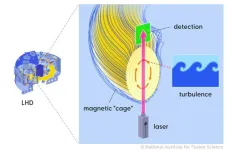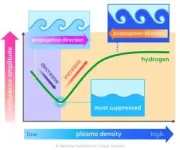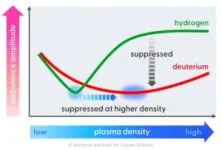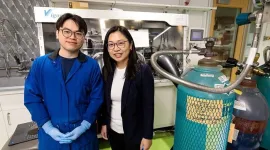Background
Fusion energy is that released when two light nuclei combine to form a single heavier one (nuclear fusion reaction). Fusion energy-based power generation (fusion power plant) uses the energy generated when deuterium and tritium combine to form helium. A nuclear fusion reaction does not produce carbon dioxide. In addition, since it is possible to extract deuterium and tritium from the sea water, fusion energy is regarded as a sustainable energy source, and research into its practical application has been progressing rapidly in recent years. To initiate a fusion reaction, deuterium and tritium must be heated to over 100 million degrees Celsius to form plasma, which is then maintained by a strong magnetic “cage”. However, when turbulence is excited in the plasma, the plasma flows out of the magnetic “cage”. Therefore, turbulence is an important topic in fusion research, and its suppression is essential to the realization of a fusion power plant. For turbulence suppression, an understanding of the physical mechanism of turbulence excitation is essential, and LHD is the perfect device to tackle this challenge. For example, generally turbulence measurement is not easy, but we have successfully measured
not only its amplitude but also its spatial profile and propagation direction using precision laser diagnostics *5 (Figure 1). Moreover, these series of experiments were conducted during a period of deuterium experimentation (2017-2022)*6 in LHD, and the ion-mass dependence of turbulence was investigated.
Result
A research group led by Assistant Professor Toshiki Kinoshita (Research Institute for Applied Mechanics, Kyushu University), Professor Kenji Tanaka (National Institute for Fusion Science, National Institutes on Natural Sciences) and Professor Akihiro Ishizawa (Graduate School of Energy Science, Kyoto University) et al. performed experiments in which the density (amount of electrons and ions) of the hydrogen plasma was changed under identical heating conditions to gain a comprehensive understanding of turbulence in LHD. At the same time, the turbulence was measured in detail. As a result, it was found that turbulence is most suppressed at a certain density (transition density), and below the transition density, it decreases with increasing density (purple region in Figure 2), but above the transition density, it begins to increase (orange region in Figure 2). Furthermore, it was observed that the turbulence propagation direction reverses after the transition density. This result implies that the turbulence nature changes around the transition density (turbulence transition).
Then, to corroborate the turbulence transition, simulations were performed on the Raijin supercomputer. As a result, we found that the turbulence observed below the transition density was mainly caused by the ion-temperature gradient, while that above it was mainly caused by the pressure gradient and plasma resistivity. Moreover, we identified that this change in the turbulence is an important physical mechanism of turbulence suppression. Thus, by making full use of experiments and simulations, we revealed that the observed turbulence suppression was due to a change in the turbulence mode, i.e., turbulence transition.
In addition, experiments under the same conditions were conducted in deuterium plasmas and compared with hydrogen plasmas. As a result, we found that turbulence transitions occur at higher density for the deuterium plasma, i.e., turbulence is suppressed at higher density (Figure 3). Furthermore, surprisingly, the turbulence observed above the transition density is clearly suppressed in deuterium plasmas. The turbulence suppression observed at high density in deuterium plasmas implies that it will be further suppressed in the higher-density and heavier-mass deuterium/tritium mixture plasmas envisioned for fusion power generation. This is a favorable result for early realization of fusion power generation.
Future Plans
This study shows that turbulence is most suppressed during the turbulence transition and the turbulence transition density is higher in deuterium plasmas than in hydrogen plasmas. The different transition densities mean that turbulence transition condition is not determined solely by electron density. The next step is to identify the turbulence transition condition based on the physical background of turbulence, and to develop innovative operation scenarios with low-turbulence conditions for fusion power plants. We would also like to extend our research into an extrapolation to deuterium/tritium mixed plasmas and their application to plant design in order to find efficient solutions for realizing fusion energy.
【Glossary】
※1 Plasma: The fourth state of matter after solid, liquid and gas. When energy is added to a gas, atoms are ionized and plasma is formed.
※2 Turbulence:Random and microscopic fluctuations of density, temperature, and potential caused by inhomogeneous density and temperature. In particular, turbulence of a few centimeters to a few tens of micrometers is supposed to cause the particle and energy diffusion.
※3 Large Helical Devise(LHD):LHD is the world's largest superconducting plasma confinement device located in the National Institute for Fusion Science. LHD employs a heliotron type-magnetic field configuration based on a unique Japanese idea, and forms a twisted magnetic field by modulated double helical coils. The magnetic field structure is different from that of tokamaks, enabling unique study that takes advantage of its features. Experiments began in 1998, and in 2017, LHD succeeded in generating plasma with an ion temperature of 120 million degrees, which is required in a fusion power plant. LHD stands for Large Helical Device.
※4 Deuterium, Tritium: Hydrogen can be classified into hydrogen (H), which has one proton and no neutrons in its nucleus, deuterium (D), which has one proton and one neutron, and tritium (T), which has one proton and two neutrons, and these are called hydrogen isotopes. The abundance ratio in nature is 99.985% hydrogen and 0.015% deuterium, with very little tritium. Deuterium can be extracted from sea water, while tritium is also formed by the reaction between neutrons produced by a fusion reaction and lithium extracted from sea water.
※5 Precision laser diagnostics:In this study, a phase contrast imaging using laser is used for direct turbulence measurements. Phase contrast imaging is a technique originally used to visualize transparent structures such as biological cells, but by using a laser as a light source, turbulence in plasma can be visualized. Furthermore, by using a two-dimensional detector, the spatial profile of turbulence can also be obtained.
※6 Deuterium experiment: It is envisioned that the initial fusion power plants will utilise the deuterium–tritium reaction. Tritium is a radioactive isotope and is difficult to handle in experiments. In order to discuss extrapolation to future fusion power plants, LHD conducted deuterium experiments from 2017 to 2022 in addition to conventional hydrogen one.
END





